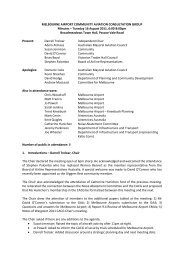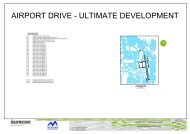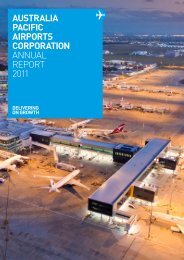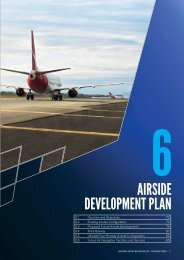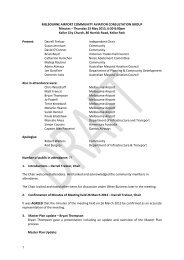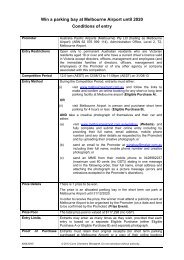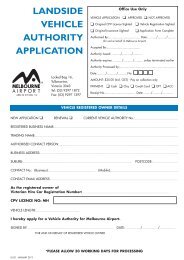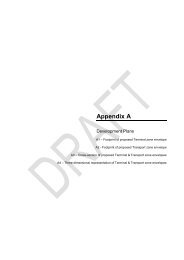Section 9 - Ground Transport Plan - Melbourne Airport
Section 9 - Ground Transport Plan - Melbourne Airport
Section 9 - Ground Transport Plan - Melbourne Airport
Create successful ePaper yourself
Turn your PDF publications into a flip-book with our unique Google optimized e-Paper software.
<strong>Ground</strong> <strong>Transport</strong> <strong>Plan</strong> :: 9<br />
The proposed road transport system will need to connect<br />
with new road links, most notably the Outer Metropolitan<br />
Ring <strong>Transport</strong> Corridor in the long term and the Bulla<br />
Bypass in the medium term. <strong>Plan</strong>ning for these initiatives<br />
is currently underway, particularly for the Bulla Bypass<br />
project. However, construction is unlikely to occur within<br />
five years for either project. These initiatives will ultimately<br />
provide additional capacity for traffic from the growth<br />
corridors to the north, north west and west. It will also<br />
safeguard the existing roads’ effectiveness as they are<br />
affected by rapid population growth in these areas.<br />
Much of the improvement on the Tullamarine Freeway<br />
will not occur in the next five years but will be critically<br />
needed, and expected, within the 20-year timeframe of<br />
this Master <strong>Plan</strong>.<br />
9.8.3 <strong>Transport</strong> Hubs<br />
The further development of the purpose-built transport<br />
hubs will streamline vehicle access into the airport. These<br />
hubs will also move private vehicles away from the front<br />
of terminals to allow expansion and improvement of<br />
pedestrian spaces. In addition, the hubs will allow<br />
travellers to remain under cover. The hubs provide<br />
the opportunity to integrate potential new check-in<br />
technologies into the transport journey. As these systems<br />
are developed and refined, they will be incorporated into<br />
strategic locations including transport hubs.<br />
9.8.4 Vehicle Parking<br />
In the long term, further parking facilities will be required<br />
to provide the parking bays proposed for development<br />
in the next 20 years. Depending on the type of parking,<br />
these facilities would ideally be located close to the existing<br />
or proposed terminal areas and visible from main roads.<br />
<strong>Melbourne</strong> <strong>Airport</strong> remains committed to offering users<br />
a wide range of value-for-money parking options. These<br />
will range from remote economy car parks to premium<br />
undercover locations close to terminal precincts. The<br />
multi-level structure with parking and a ground transport<br />
interchange that is currently being designed as part<br />
of the Southern Precinct Program is a good example.<br />
The new elevated road network within the airport will<br />
allow greater access and therefore a greater variety<br />
of car parking options that, in general, will result in<br />
improved proximity to terminals and reduce travel time<br />
for airport users.<br />
9.8.5 Bus<br />
In the long term, the bus system will be expanded and<br />
improved to provide more reliable, comfortable, safe,<br />
affordable and frequent services, with comparable or<br />
better travel times than for private vehicles. The new bus<br />
network will connect key activity centres and provide a<br />
viable and equitable transport choice for all airport trips.<br />
The new elevated road network will provide buses<br />
at ground level with priority access to new transport<br />
interchanges with high-quality facilities, retail areas, and<br />
dynamic information on arrival and departure times.<br />
DRAFT<br />
A renewed focus on building capacity and multi-passenger<br />
vehicles, including all forms of public transport, will<br />
be a high priority for <strong>Melbourne</strong> <strong>Airport</strong> and all levels of<br />
government. This includes developing traffic management<br />
systems as congestion grows.<br />
Increasing bus usage and the need for additional services<br />
will be important, particularly if a rail link continues to be<br />
unavailable. In that event, bus services will need to fill the<br />
void so that the imperative of increasing the use of<br />
high-occupancy vehicles continues to be met. The<br />
increase in bus services would cater for regional and<br />
metropolitan passengers.<br />
MELBOURNE <strong>Airport</strong> Master plan 2013 – PRELIMINARY DRAFT : : 131




